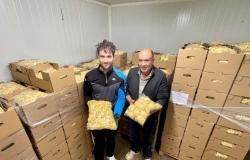By
Sebastien Lucot
Published on
June 13, 2024 at 3:46 p.m.
See my news
Follow La Presse de la Manche
“Today, the cows are fed like pigs, very often in buildings, even though they are ruminants. »
For 24 years, Emmanuel Auguste has worked alone on his dairy farm located in Trelly, in Center-Manche, and advocates pasture of his cattle Norman breed.
Corn, “an ecological disaster”
While on a national scale, corn remains the main culture irrigated in France and alone represents almost half of the irrigated areas, this agricultural model today shows its limits.
Copiously subsidized by France – the aid being for years 1990 much more important for a hectare of corn than a hectare of grass – should this agricultural policy, at a time of climate change, be rethought?
“We need corn. But when I see certain farmers around me who are expanding, almost double, their area of cultivation of this crop…” expresses Emmanuel Auguste, one of the twelve members of the Economic and Environmental Interest Group (GIEE) Low Carbon Organic Milk from the South Channel, awarded at the 2024 Agricultural Show as part of the agroecology trophies.
At a time when longer and more intense droughts are threatening Europe, corn, which consumes water, does not only have advantages, particularly from an environmental point of view. “You should know that one hectare of meadow stores 500 kg of carbon per year. One hectare of corn, with all the necessary equipment passages to work it and feed the animals, releases 500 kg of carbon», assures54 year old organic farmer.
45 plots of meadow
Corn alone is not enough to feed cattle. A supplement must be added, soymainly imported fromSouth America. “The entire corn cycle is a ecological disaster , especially when we do the same in France. »
THE food cost of exploitation is also divided by four according to Emmanuel Auguste, who did the accounts: “For a ton of dry matter on a conventional farm, the production cost is 80 euros. With just pasture, it’s 20 euros,” explains the man who, today, manages to get two SMIC and leave vacation summer.
If he produces 320,000 liters of milkper year with its livestock of one hundred cowsincluding around thirty heifers and a few calves, this man, having a love of the profession, ensures that with good management of the dynamic grazingcattle can be fed only on grass that they graze in the fields “from mid-November to mid-February”.
Behind Emmanuel Auguste’s farm, meadows as far as the eye can see. From his virgin fields, he managed to create 45 plots. Counting 1.2 are per animal per dayhe changes his paddock herd every day with the help of Tania, a Border Collie.
He planted 31 km of hedges
In May, when the growth is greatest, the grass in its plots, with a height of 15 to 20 centimeters , achieves optimal nutritional value. “It takes about twenty days for her to get there. »
It is at this time of year that Emmanuel most often takes out his tractor – which he uses very little – to mow and store fodder for winter or summer, during periods of drought. “As the cows turn over in 45 days on my 45 paddocks, the growth goes faster than their nutritional needs. So I can stock up. »
To delimit this grid of its meadows, 31 kilometers of hurdleswere planted by the Manche farmer. “It’s 2,500 euros each year to maintain them. A cost, it’s true. But it retains water and cuts wind,” assures the one who highlights the non-use of pesticides. A shame for the fifty-year-old who began his professional life as a salesman, for around ten years, pesticides. “The worst part is that today, so many have never been sold. »
Follow all the news from your favorite cities and media by subscribing to Mon Actu.






